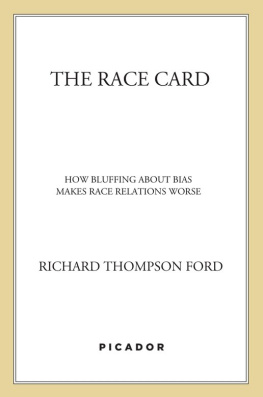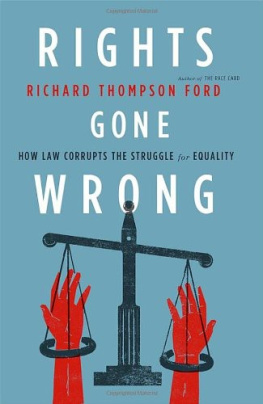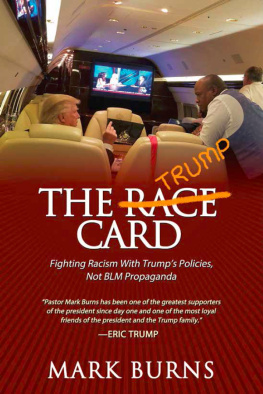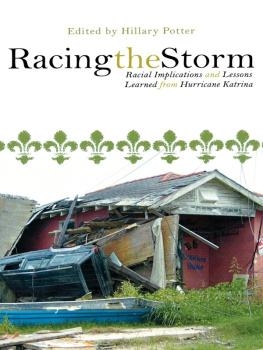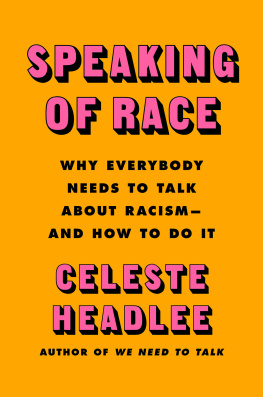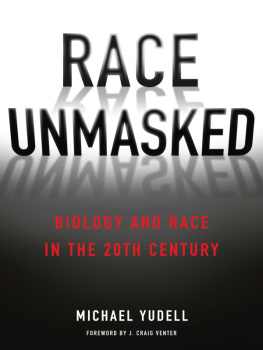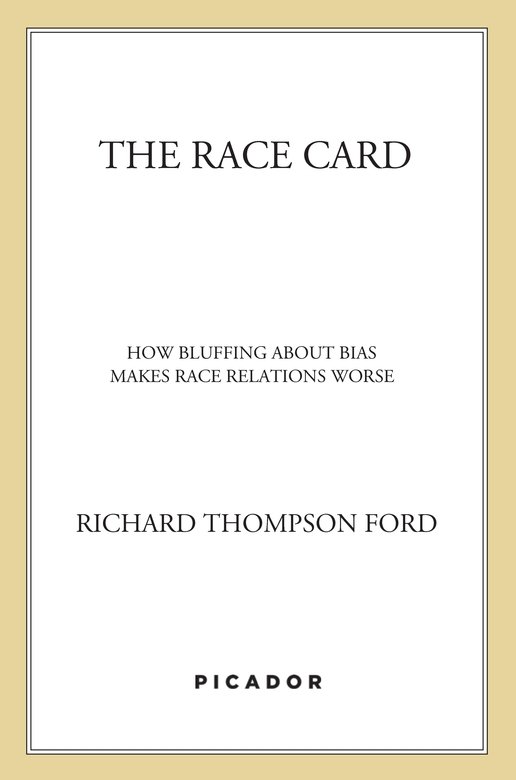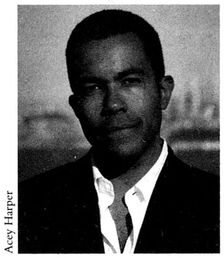People often say that writing is a solitary efforthours spent alone, quill in fist, parchment on the writing blotter (or fingers poised over the keyboard, eyes fixed on the screen). But this is only half true. Successful books are group efforts: conversations inspire ideas; discussions while the work is in progress improve them; editors temper polemical excesses and correct potentially embarrassing errors. The Race Card has benefited from the very best of all of these helpful influences: its virtues are much to their credit and its flaws are probably entirely the result of my failure to exploit them.
Here are some of those influences, in no particular order.
I gave lectures based on chapters of this book at the Stanford Law School, the Harvard Law School, and the American Universitys Washington College of Law. I received extremely useful feedback each time.
My thinking about discrimination and bias has profited from the lecturesand written scholarship of, and countless private conversations with, my colleagues at Stanford Law School. I should simply list the entire faculty, but even in such an outstanding group a few stand out. Mark Kelman has been a mentor and friend since I joined the faculty in 1994his work analyzing federal antidiscrimination lawespecially his book Jumping the Queue , coauthored with Gillian Lesterhas formed the backbone of my thinking. Rick Banks has been a friend and collaborator, consistently challenging me with thoughtful, counterintuitive, and utterly convincing work. Barbara Friedone of the most rigorous and serious humanists in the legal academyhas been a profound intellectual influence, a role model, a mentor, and a generous and charming friend.
Kathleen Sullivan was a supportive dean during her tenure; she encouraged both intellectual excellence and public relevance and thus helped inspire me to write a book for a popular audience. Larry Kramer has been a wonderful deanthoughtful, intellectually engaged, patient, and generous with every resource a scholar might need.
I first began to think hard about the relationship between race and the law after taking a course from Randall Kennedy as a student at the Harvard Law School. His intellectual influence and guidance have continued ever sincehe is a role model of intellectual curiosity, integrity, and courage. Ive been engaged by many conversations and constructive disagreements about the nature of bias and the limits of the law with Kenji Yoshino of the Yale Law School. My thinking about race and the law owes a great deal to Reva Siegel and Robert Post of the Yale Law School; my discussion of appearance discrimination in particular was heavily influenced by Posts excellent book Prejudicial Appearances .
My fusion of social criticism, political philosophy, and legal analysis reflects the profound influence of two of Harvard Law Schools most challenging and charismatic professors: Duncan Kennedy, a true polymath whose mastery of a wide range of intellectual traditions is matched only by his professional generosity and joie de vivreI owe my career in academia to his help and encouragement, and a better mentor, friend, and occasional martini drinking companion I cannot not imagine; and Gerald Frug, whose wit, passion, and agile intellect transform any legal conflict into an urgent social dramaI owe my first and greatestintellectual interest, the intersection of law and urban studies, to his influence.
One influence deserves a paragraph of her own. I owe whatever ability I have to think clearly about the relationship between law and culture to my dear friend and former colleague Janet Halley, now, much to my personal regret, of the Harvard Law School. Janet has raised lucid thinking and intellectual courage to the level of what can only be called moral virtue (though she would resist such terms). She has a downright eerie instinct for the intellectually challenging and counterintuitive insight, a philosophers sense of the profound, a comic playwrights sense of the absurd, and a poets sense of the sublime. My analysis of racism by analogy owes its genesis to Halleys courageous and lucid article Like Race Arguments, and my analysis of the connection between feminism and gay rights owes a great deal to her scholarshipespecially her brilliant book Split Decisions and to our many private conservations.
Farrar, Straus and Giroux has been exactly what a scholar needs from a publisher. From the beginning, FSG has believed in this projectnot just in its potential to sell books but also in its potential to contribute to public discourse about race. Eric Chinski has been a sensitive and engaged editor: hes helped correct my excesses and obscurities while amplifyingbut never distortingmy voice. Our many conversations have improved the books substantive content as well as its exposition. My agent, Wendy Strothman, has done more than I imagined an agent could or would be willing to doshe took an interest in the project when it was just a few vague ideas expressed in a ten-minute conversation; she make sure it found, not just a publisher, but the right publisher; and she has continued to discuss it and help improve it as it has developed.
Finally, Marlene Williams Ford has given me her support, insight, enthusiasm, patience, and most of all, her love, and Cole Ford has offered his toddlers energy and love, and given me a healthy sense of perspective.
A t the dawn of the twenty-first century the United States swore in its first black president. The tall, handsome, and charismatic senator had survived the smear tactics and dirty tricks of his rival for the Democratic nomination, the bad press generated by his opinionated and outspoken spouse, a bitter fight in the general election, and the threat of assassination when he took the oath of office. President David Palmer made history in the hit counterterrorism drama 24, becoming the most popular president since Ronald Reagan, easily besting his ratings rivals Jed Bartlet of The West Wing and Commander in Chief Mackenzie Allento say nothing of such prime-time mediocrities as William Jefferson Clinton and George W Bush.The nation felt in good hands with President Palmer, secure in the knowledge that a strong, ethical, and pragmatic leader would keep the homeland secure from terrorist threats, both foreign and domestic. The Nielsen ratings proved that the average American would not only accept a black presidentthey would embrace him.
Four years later Barack Obama announced his run for the presidency. Obama had been the one bright spot at the 2004 Democratic convention, delivering an inspiring speech at a gathering otherwise notable for its canned ideas and lifeless orations. But at age forty-seven Obama would be one of the youngest presidents in American history. He was conspicuously elite, if not elitist: a graduate of Honolulus prestigious Punahou prep school, the exclusive, clubby Occidental College in Los Angeles, Columbia University, Harvard Law School. He was foreign and exotic. He had a Kenyan father and had been raised in Indonesia and Hawaii. He would have to compete for the Democratic nomination with party insiders such as Joe Biden, who had served in the Senate for thirty-five years, John Edwards, who as John Kerrys running mate in 2004 had charmed and impressed Democrats in debates against Dick Cheneythe Darth Vader of the Republican partyand Hillary Rodham Clinton, who could call on her husbands political connections and campaign organization, which was the most well-developed and effective machine in modern politics. And, if these liabilities werent daunting enough, Obama was black. Ignoring the precedent of David Palmer, insiders concurred that Americans werent ready for a black president: Obama didnt have a chance.

